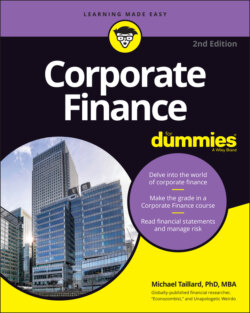Читать книгу Corporate Finance For Dummies - Michael Taillard - Страница 69
Looking at the different types of stock
ОглавлениеLike most aspects of corporate finance, stocks come in many varieties, but no matter which type of stock your corporation has, its value increases or decreases based on the performance of your corporation. Here are three of the main stock types, along with their distinguishing characteristics:
Common stock: If you hold common stock in a corporation, you’re a partial owner, so you get to vote in any decisions regarding company policy, the board of directors, and many other issues. Keep in mind that to be brought to a vote, an issue usually needs to be instigated by one stockholder and then supported by others, at which point a voting form goes out to all stockholders of that company to fill out and return.Holding common stock also gives you rights to a share of dividend payments (profits returned to the company owners) when they’re issued, although this is optional. In case of company liquidation (selling assets after going out of business), common shareholders get whatever value is left over after the lenders and preferred shareholders get what they’re owed. Finally, holding common stock gives you the right to receive specialized reports or analytics from the company.
Preferred stock: If you hold preferred stock in a corporation, you get your dividend payouts in full before common shareholders get even a dime. That holds true for liquidation as well. As with common stock, being a preferred shareholder gives you the right to get information from a company. But the key difference between common and preferred shareholders is that preferred shareholders don’t have voting rights. So, although they have a right to the ownership and success of a company, they have no voice or control over the actions the company takes.
Treasury stock: When a company issues common shares of stock, it has the opportunity to repurchase those shares on the secondary market as any investor does. When a company does so, those common shares become treasury shares. The stock itself hasn’t changed at all; it’s just owned by the company that the stock represents. So, in essence, the company owns itself, which is only one step away from becoming completely self-aware and destroying us all! Companies tend to do this (buy treasury stock, not destroy us all) because they can generate income in the same way that many investors do, but buying treasury stock also allows them to manage their stock price more effectively.
Another stock-related term you need to know, though it isn’t a type of stock per se, is stock split. A stock split occurs when a company takes all of its common shares of stock and splits them into pieces. For example, say a person had one share of stock worth $10 before a stock split. After the split, that person has two shares of stock each worth $5. Companies use stock splits to increase the liquidity of stock shares, making them easier to buy and sell and, in the long run, driving up the total value. Note that this process can easily backfire if there isn’t already a demand for a company’s stock from people who would buy it at the cheaper post-split rate.
